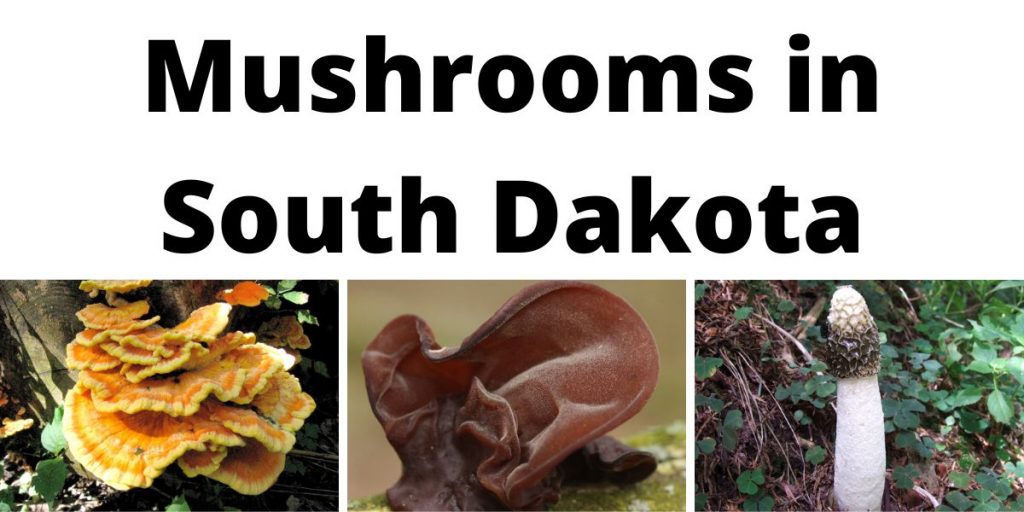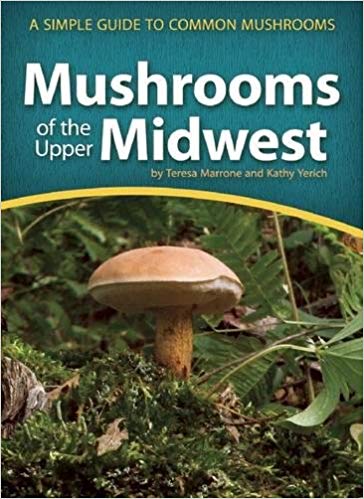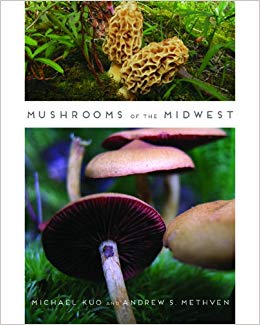South Dakota[i] is a large state with few people. Its summers are hot, with often-violent weather. Its winters are cold. Most of the state is dry grassland or agriculture, though the Black Hills region is densely forested. With such varied conditions, a wide variety of mushrooms can be expected—and indeed, the mushrooms are here. But the state does have a mycological oddity. We’ll get to that in a bit.
We’re not saying you should go out foraging in South Dakota with this list as your guide—if you are a beginner with mushrooms, you should not go foraging without expert help. It’s not that mushrooms are really all that difficult to identify (OK, some are, but many are not), and in fact most are safe to eat (though not all edible mushrooms are good). Instead, the issue is that beginners often have trouble with the judgment calls foraging requires. For example, say you find a mushroom that looks almost like a mushroom in your guidebook but not quite. Is it an atypical example of the species in the book, or is it a different species that is not in your book at all? Before you go out harvesting even the easy-to-recognize species, you should have enough experience behind you to know.
If you do indeed go Mushroom Hunting make sure you have the proper tools, take a quality knife with you and a basket/bag for your haul!
This article is is a list of reasons to go out and get that experience[ii]. This list is not meant to be used as a replacement for a field guide, spore prints, an identification app or an in person guide.
Our Recommended Field Guides for South Dakota
COVER | TITLE | Header | ||
|---|---|---|---|---|
OUR #1 RATED | ||||
Edible Mushrooms in South Dakota
Dryad’s Saddle (Polyporus squamosus)
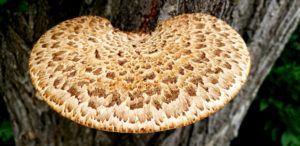

Dryad’s saddle[iii], also called pheasant back (it actually can be mistaken for the back of a pheasant when seen through the trees) is marginally edible. That is, it’s safe to eat but has such a rubbery texture that it’s difficult to prepare in such a way as to make it palatable. But it’s such a large mushroom that if you can find a way to prepare it properly, you’ll have leftovers. Like many polypores, it can also be used to make lovely and functional paper.
Chicken-of-the-Woods (Laetiporus sp.)
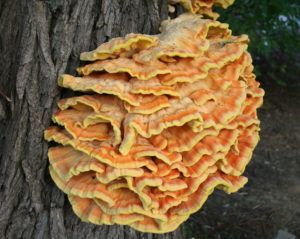

Chicken-of-the-woods, also called sulfur shelf, is a group of very similar shelf fungi. Most are orange and yellow, though some have white or pink in their color patterns, too. As the name implies, they taste like chicken. Because of the distinctive color, it’s usually easy to figure out that a chicken is a chicken, but deciding which chicken you’ve got is harder. The fact that many writers don’t seem to know there is more than one chicken-of-the-woods species (in fairness, this is a relatively new discovery) doesn’t help.
The plurality of chickens is a bit of a problem because while some species are choice edibles, others are tough and only palatable along their edges, and some are even mildly poisonous. For many years, the fact that some people got sick after eating chicken-of-the-woods was attributed to toxins supposedly acquired from the substrate tree—you can still find writers confidently asserting this explanation. Unfortunately, it’s not entirely clear which chickens South Dakota has.
Be aware that there are other mushrooms with names similar to chicken-of-the-woods. When in doubt, check the scientific name.
Wood Ear (Auricularia sp.)
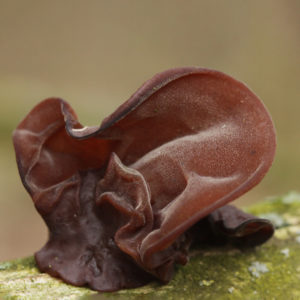

Wood ear does, in fact, look like a brown human ear growing on a tree—or at least some specimens do. In others, the resemblance is not so close, depending on the way the gelatinous tissue wrinkles and folds. It doesn’t look like it ought to be appetizing, and descriptions of the thing as tasteless and gelatinous don’t really help, but the wood ear actually is excellent in soups and sauces. That’s because it easily absorbed and holds the flavor of whatever it’s cooked in. As for texture, “gelatinous” isn’t quite accurate. Neither is “crunchy,” the other adjective normally applied. It’s hard to describe. But next time you order Chinese food and find brown wiggly bits in the sauce, you’re gonna want to not skip those[iv].
There are multiple species of wood ear growing across much of the world, but they all are often listed under the same scientific name, one that properly belongs to a species that doesn’t grow in North America at all[v]. Which wood ear does grow in South Dakota is not clear
Shaggy Mane (Coprinus comatus)
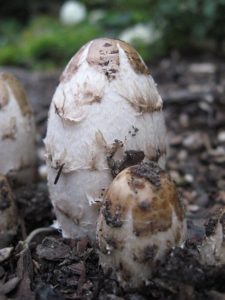

The shaggy mane[vi] is one of a group of mushrooms that all share a curious trait; at maturity, they turn into black ink and drip away (yes, literally ink—the stuff has been used to write with). Most (not all) are edible, but shaggy mane is among the best. It’s also safe to eat with alcohol, something that is not true of all inkcaps.
Shaggy mane is fragile and has a short shelf-life, since almost any kind of stress will speed up the conversion to ink. If you want to eat mushrooms, an inky mess won’t really work. However, the ink is edible, with a rich, mushroomy flavor. It can be used in many different recipes, including pasta dough and flavored butter.
Shaggy mane is very distinctive-looking, though could be mixed up for some of the other inkcaps, some of which are not safe to eat with alcohol. Toxic Amanitas are sometimes mistaken for shaggy man also, for though the resemblance is not close, it is close enough for wishful thinking to take over. Pay attention to detail, please.
Common Stinkhorn (Phallus impudicus)


The common stinkhorn is aptly-named; it stinks. Also it looks like some sort of strange, alien penis. Most people assume that these things must be inedible, but in fact they are quite safe to eat, and some folks like them. The taste can be acquired. Stinkhorns are eaten in their early “egg” stage,” when the young mushroom is entirely encased by a soft shell of tissue. Since Amanitas also have an egg stage and can be dangerously toxic, it’s important to slice stinkhorn eggs vertically to double-check identification before cooking—look for the dark gleba layer, which Amanita eggs don’t have.
The common stinkhorn is just one of a group of related fungi, all of which stink (their spores are spread by flies) and have strange shapes—besides the several phallic species, there are those that look like octopuses, Wiffle balls, and other things. Many are edible, and some are considered delicacies in Asia.
Ash Bolete (Boletinellus merulioides)


The ash bolete, so named because it sometimes grows under ash trees, is part of a large group of related mushrooms called the boletes—parasol-shaped mushrooms with pores rather than gills. Not all boletes are safe to eat, but many are. The taxonomy of the group is in rapid flux, by the way, to the point where common names are often more reliable than scientific ones, because the scientific names change so often!
Ash bolete is not considered choice, as the flavor is a bit bland, and some people have trouble with the slippery texture. Older specimens develop an additional texture problem as their spore layer gets a little strange (the spore layer is easy to remove, though). But some people are very fond of ash boletes. Drying these mushrooms gives them a flavor similar to walnuts, and fresh ones are very nice cooked with crunchy breadcrumbs and garlic[vii].
Pavement Mushroom (Agaricus bitorquis)
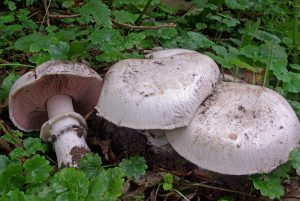

Here is one of the wild relatives of those White Button things you can get on pizza—the actual common name of which is “Mushroom,” believe it or not. Over time, the word has come to refer to the fruiting bodies of virtually all macro fungi, but it started out attached to just one species, the one now sold as White Buttons, Criminis, and Portabellos, depending on age and color. A small group of other species can legitimately be called wild mushrooms because they are closely related to the domestic form and quite similar to it. Some (not all) are safe and enjoyable to eat. The pavement mushroom[viii] is one of these, so named because it often pops up under roadways and sidewalks and can push the pavement out of the way. Accounts of its flavor vary widely from not worth eating to excellent. You may have to decide yourself.
Our Recommended Field Guides for South Dakota
COVER | TITLE | Header | ||
|---|---|---|---|---|
OUR #1 RATED | ||||
Poisonous Mushrooms in South Dakota
Many sources insist that there are no poisonous mushrooms in South Dakota. That’s probably not true, and you should definitely exercise caution when foraging just as you would in any other state, but getting a list of poisonous species actually confirmed to grow in South Dakota is difficult. We actually could not find such a list ourselves. Strange, but it’s true.
It is worth noting that in some cases which mushrooms count as poisonous is debatable. Many well-known edibles do sicken some people, especially if they haven’t been cooked properly, for example. Also, please note that while the psilocybin mushrooms are generally not considered poisonous, that’s really only because a lot of people enjoy the poison. Imagine eating a meal of magic mushrooms without knowing what they were? And serious side effects are possible, especially in children.
So please do be careful with mushrooms in South Dakota, especially those that look a bit like poisonous mushrooms common in other states. We can’t give you a list of poisonous species, but that doesn’t mean any mushroom you find in the state would be good for lunch.
Pay special attention to Little Brown Mushrooms which often look incredibly similar, and can be confused for the Deadly Galerina.
Magic Mushrooms in South Dakota
Magic mushrooms may be the closest thing South Dakota has to documented poisonous mushrooms, but really they are among the safest means of altering consciousness around. Psilocybin deserves respect as a substance that is not entirely risk-free, but many people use it without difficulty. Of course, it is illegal in many jurisdictions.
There are at least two psilocybin species growing in South Dakota[ix].
Banded Mottlegill (Panaeolus cinctulus)
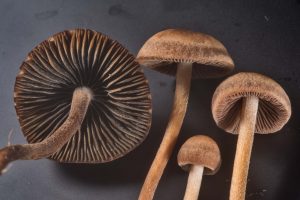

The Banded Mottlegill is so called because the rim of the cap is paler than the center, a pale band, plus the spores develop unevenly, giving the gills a mottled appearance. “Mottlegill” is the common name of members of the Panaeolus genus generally, but curiously psychonauts tend not to use common names, referring simply to members of this genus as pans. In any case, while some pans are very potent and others are not psychoactive at all, P. cinctulus is middle-of-the road, slightly on the weaker side but still quite respectable. Let’s make it simple, it is less potent than the popular Psilocybe Cubensis.
Gymnopilus sp.
The Gyms, as they are often called, are not popular among psychonauts, so there isn’t a lot of information published about them. Their high is said to be qualitatively a little different from that of most other psilocybin-containing mushrooms, though. The taxonomy of the group is somewhat muddled at present, and it’s not clear which gym South Dakota has but they can be found.
Our Recommended Field Guides for South Dakota
COVER | TITLE | Header | ||
|---|---|---|---|---|
OUR #1 RATED | ||||
References:
[i] (n.d.). South Dakota. Wikipedia
[ii] (n.d.). South Dakota Mushroom Hunting. TREEfool
[iii] Volk, T. (2001). Tom Volk’s Fungus of the Month for May 2001. Tom’s Fungi
[iv] Covington, L. (2022). What Are Wood Ear Mushrooms? The Spruce Eats
[v] Kuo, M. (2018). Auricularia “americana.” MushroomExpert
[vi] Bergo, A. (n.d.). Foraging and Cooking Shaggy Mane Mushrooms.
[vii] Bergo, A. (n.d.). Ash Tree Boletes or Boletinellus merulioides.
[viii] Wood, M. Stevens, F. (n.d.). California Fungi—Agaricus bitorquis. California Fungi
[ix] (n.d.). Which Psilocybin Mushrooms Grow Wild in My Area? Shroomery


